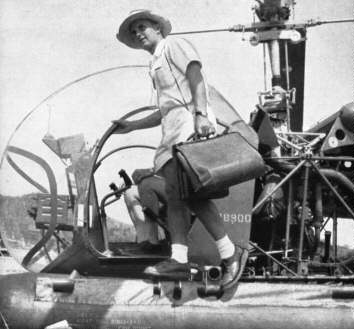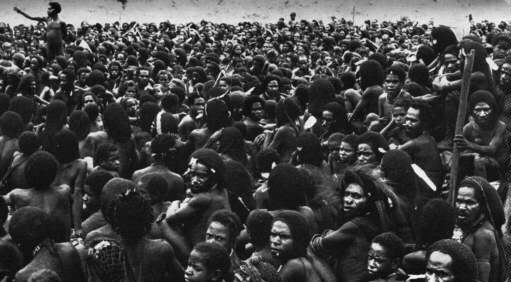
|
|
| Cannibal Culture | |
|
Selected excerpts from Jens Bjerre’s The Last Cannibals on primitive beliefs and customs New Guinea |
Ships From Heaven
In the ’thirties many of the natives in the Central Highlands heard, for the first time, the far-away sound of an aeroplane. They were frightened. What could the noise possibly be? Was it an earthquake, or the sound of distant floods? Or was it the sound of a large bird of prey? The noise went on and soon they saw a large, shiny bird – an aeroplane. They threw themselves to the ground in terror and dared not look up for fear of being killed if the birds should see them. When the terrifying sound at last faded behind the mountains they rose and looked around. They agreed that something must be done to protect themselves against this huge and doubtless predatory bird. So they melted some pig’s fat and poured it out over the soil as an offering to the spirits of their forefathers. Then they took some leaves which had a protective power and tied them in their hair and over their burdens to protect them against the bird’s deadly magic. Time passed, and other aeroplanes were seen and heard. From the northerly Kamano district, where a new station had just been opened, came some strange rumours. It was said that the flying object was called ‘The bird of the heavenly mother’ and that it carried many white men in its belly which were dropped out when it touched the ground. Slowly they got accustomed to the bird, but they were still afraid of it. Yet, as it did not seem to hurt anybody, they began to think they were mistaken about its evil power. They wondered a lot who these men were and where they came from. Since they came from Heaven they must be heavenly beings.
The natives were familiar with many stories about the heavenly world, and about the people from Heaven who visit the earth: people (said the myths) who were white because they had been so near to the sun. The white men were powerful beings, who could rule lightning and thunder and all the elements of the world. They came from Anabaga – the world of the dead; they were their forefathers’ spirits sent back to life again by the two great spirits of their myths: Jugumishanta and Morofonu. It all seemed to make sense for a primitive brain.

Fear of the unknown dominated their imagination. As the natives around the new post at Kainantu in the Highlands gradually got used to the sight of the white men, they used their new-found knowledge about him to impress and overawe their more ignorant neighbours, who themselves had not seen these strangers. The rumours spread widely, like rings when a stone is thrown into water, and as the stories passed from mouth to mouth, from village to village and from tribe to tribe, they became more and more farfetched. One rumour disseminated from Kamano was that, when the white men came, all pregnant women would die; they would be killed by snakes which the white men would bring along and which would penetrate their wombs and cause death. To prevent this, the husbands of the pregnant women made aprons of bark which they tied round the waists of their wives to conceal the fact that they were pregnant. To make doubly sure they fitted them out with bark napkins. Some of the women got so worked up with terror that they aborted the unborn child to save their own lives. In some of the villages the men built a large hut capable of holding all the inhabitants. They collected a large supply of food and water and all of them, men, women and children barred themselves inside the hut.
The men carried out various rites: one was to chew a flower called Oggona and spit it out on the pregnant woman’s body to counteract the venom of the ‘snakes.’ The men kept watch during the night, while the women slept. Another magic they employed was to slaughter several pigs and spray the blood over the bellies of the pregnant women and over the threshold of the hut. The idea was to deceive the snakes into believing that the women had already been killed. They kept this up for some days, but there was no sign of the ‘snakes’ nor of the evil spirit Katokkatoveifani, who was supposed to accompany them; so they decided to leave the hut, now believing that the rumours from Kamano must be false. When they left the hut, however, they killed some more pigs and sprayed more blood upon the women.
Shortly afterwards a man came back from Kamano with the news that the spirits of the dead, that is to say the white men, would give sea-shells and other riches to their friends and relations. This tale, of course, was based on the fact that the Europeans at the Kainantu post gave the neighbouring natives sea-shells, knives, axes, empty food tins, tobacco, cloth and salt in exchange for pigs and produce from the fields. The natives assumed, however, that these gifts were the rewards of those who had observed the proper ceremonies for the dead. More and more rumours arrived from Kainantu, where the natives kept on getting presents in exchange for food. Some of the presents were subsequently traded from village to village and afforded visible proof that the stories were true. But because these ‘presents’ trickled through into the interior on such a scanty scale the natives concluded that the spirits, in the shape of the white men, were angry with them, so they went through various rituals to appease the visitants. But as only an occasional knife or a few sea-shells arrived, they believed that the Europeans were deliberately withholding the presents which the forefathers’ spirits in Heaven had sent them. The belief that the white men were their reincarnated forefathers remained unshaken, but when the natives did not get the presents they expected, they turned against them. The confusion into which the primitive mind is thrown by the impact of white civilization was revealed by another widespread native movement which developed in 1940 among the natives around the Markham valley of Northern New Guinea, who had been under the influence of the missionaries. The natives in the villages of Tamper, Mirir, Omisuan, Wampur and Arau built themselves some huts which they called ‘wireless houses’ through which, they imagined, they would receive messages from the tribes along the Markham river. The huts had little poles on their roofs, a pitiful imitation of the radio masts on the Government posts. The natives used to assemble these huts and do military exercises with sticks for rifles. They believed that Jesus was to arrive soon, and that the news of his arrival would be received at the ‘radio huts.’ They were learning how to use rifles for, they said, when Jesus came he would help them all to get the real weapons so that they could throw the whites out of the country. In the village of Wampur there was a different prophecy. The sticks with which they were doing their exercises would be turned into torches when Jesus came, and when the torches were burned down they would all wake up in Heaven.

When the authorities heard of these goings-on they told the natives that the Government would, of course, be advised of Jesus’s arrival and would pass the news on. This handling of the situation quietened the natives; but a year later another manifestation developed. The natives in the village of Omisuan heard rumours that their forefathers’ spirits in Heaven had sent them a large supply of goods. It was the usual story – that the white men in Lae had kept the goods back in order to force the natives to work. But the spirits had discovered this trick and were themselves coming down to earth to distribute the presents. The natives, therefore, deserted their fields and let their food rot. One of the men, a former plantation boy, was appointed as go-between between the spirits and the village, and took up residence in a ‘radio hut.’ The inhabitants anointed themselves with oil sent them by the Markham River natives which, they believed, would help them to turn their black skins white, and ensure that they would receive the same goods as the white men got.
Such were the delusions the poor primitives developed from the well-meaning efforts of the missionaries to care for their black souls. The villages of Omisuan and Arau, especially, had been under the influence both of Lutheran and Adventist Evangelists, whose talk of Doomsday and the Second Coming had become inextricably muddled with the mythology and beliefs of these hapless pagans and had produced a religio-political ferment among their numbers. These spiritual crises have occurred during the last twenty years among many other primitive people in New Zealand, the Fiji Islands, Java, the Celebes, the Solomon Islands and, especially, in Africa. The Mau Mau movement in Africa originated in a confused magic which took a political turn when ex-service tribesmen organized a military rising. The Australian authorities in New Guinea have realized that governing a primitive people involves a sympathetic insight into their minds. Australian anthropologists and psychologists have been assigned to study and analyse the various ‘movements’ among the natives, and nowadays all officials posted to New Guinea have to go through a course of anthropology at the University of Sydney. The white man has brought peace to the cannibal tribes of New Guinea, but he did not at first realize the high price paid for this peace in terms of the disruption of the native’s ancient way of life.
Jens Bjerre, The Last Cannibals, Michael Joseph, 1956 pp. 182-187